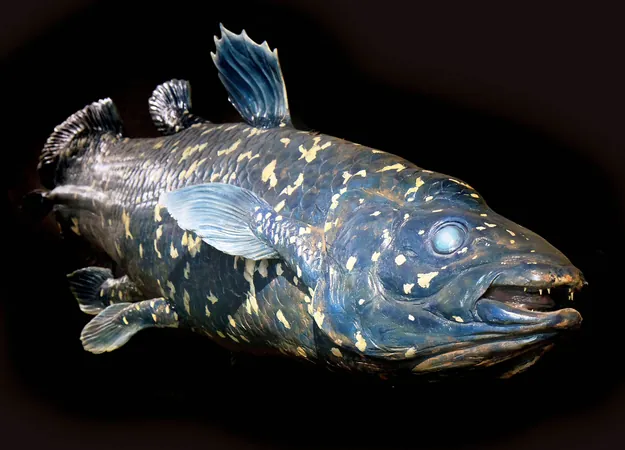
Rediscovery of the Coelacanth: The Fish That Defied Extinction for 60 Million Years
2025-03-25
Author: Ying
Rediscovery of the Coelacanth: The Fish That Defied Extinction for 60 Million Years
In what can only be described as one of the greatest surprises in marine biology, the coelacanth, a fish thought to have been extinct for 60 million years, was brought back into the limelight thanks to an astonishing discovery in the late 1930s.
Before this revolutionized understanding, experts asserted that the coelacanth had disappeared from the Earth about 65 to 70 million years ago, symbolizing a bygone era of our planet’s history. However, everything changed when a 32-year-old museum employee in East London, South Africa, stumbled upon an unusual specimen presented by a local fisherman near the Chalumna River. This remarkable find baffled her, as it did not fit any known category of fish.
Upon seeking advice from Professor James Leonard Brierley Smith at Rhodes University, it was confirmed that she had indeed discovered a living coelacanth. This unexpected event marked the coelacanth as a prime example of a “Lazarus taxon,” illustrating how species can seemingly vanish from the fossil record only to reemerge later, challenging our assumptions about extinction and survival in the animal kingdom.
The excitement surrounding this revelation was palpable, encapsulated by Brierley Smith’s iconic telegram: “MOST IMPORTANT PRESERVE SKELETON AND GILLS = FISH DESCRIBED.” Since that day, the coelacanth has become a symbol of resilience in the natural world.
In just a few years after the initial rediscovery, a second coelacanth was caught in 1952 by fishermen in the Comoro Islands, and further exploration in the 1990s led to the identification of a second species residing around the Indonesian archipelago, aptly named the Indonesian coelacanth (Latimeria menadoensis).
Unique Adaptations and Ancestral Connections
Physically, the coelacanth is mesmerizing. It boasts lobed pectoral fins, a feature believed to be a primitive link to the early vertebrates that eventually ventured onto land. This fish also possesses a peculiar hinge in its skull that raises intriguing questions about its feeding mechanics. With a camouflage coloring blending seamlessly into the rocky ocean floor, the coelacanth effectively eludes predators while its low metabolic rate allows it to thrive on limited resources.
Habitat plays a crucial role in the coelacanth's survival. It usually resides in undersea lava caves that offer sanctuary from larger threats, highlighting an effective evolutionary strategy: staying in an environment that remains largely unchanged over geological epochs.
Classification of the coelacanth falls under the group Sarcopterygii, or lobe-finned fishes, which share common ancestry with lungfish and the first amphibians, reptiles, and mammals. This connection emphasizes how certain physical traits facilitate a deep historical narrative linking aquatic life to terrestrial evolution. Additionally, its rostral organ, found in its snout, serves as an electric sense organ, aiding in locating prey, further indicating the evolutionary marvel the coelacanth embodies.
Understanding Marine Evolution and Biodiversity
The story of the coelacanth is not merely a tale of survival but a powerful reminder of the importance of biodiversity and the mysteries that continue to lie in ocean depths. Scientists are increasingly intrigued about what else might inhabit these remote underwater realms—creatures that might be among those we previously dismissed as long gone.
As research on this ancient fish continues, each discovery adds layers to our understanding of marine evolution. The coelacanth’s robust adaptability enhances our appreciation for the intricacies of life within the sea and reinforces the need for sustained exploration of deep marine ecosystems.
The coelacanth represents an extraordinary chapter in the history of life on Earth, echoing the resilience of life forms that have withstood the tests of time—a living fossil that challenges our understanding of extinction and continuity in the fiercely changing tapestry of life.
With the marine world still largely uncharted, every sighting of this remarkable fish raises an alluring question: what other long-lost creatures lie in waiting, hidden within the ocean’s profound mysteries?
Stay tuned as we continue to unravel the secrets of the deep!




 Brasil (PT)
Brasil (PT)
 Canada (EN)
Canada (EN)
 Chile (ES)
Chile (ES)
 Česko (CS)
Česko (CS)
 대한민국 (KO)
대한민국 (KO)
 España (ES)
España (ES)
 France (FR)
France (FR)
 Hong Kong (EN)
Hong Kong (EN)
 Italia (IT)
Italia (IT)
 日本 (JA)
日本 (JA)
 Magyarország (HU)
Magyarország (HU)
 Norge (NO)
Norge (NO)
 Polska (PL)
Polska (PL)
 Schweiz (DE)
Schweiz (DE)
 Singapore (EN)
Singapore (EN)
 Sverige (SV)
Sverige (SV)
 Suomi (FI)
Suomi (FI)
 Türkiye (TR)
Türkiye (TR)
 الإمارات العربية المتحدة (AR)
الإمارات العربية المتحدة (AR)